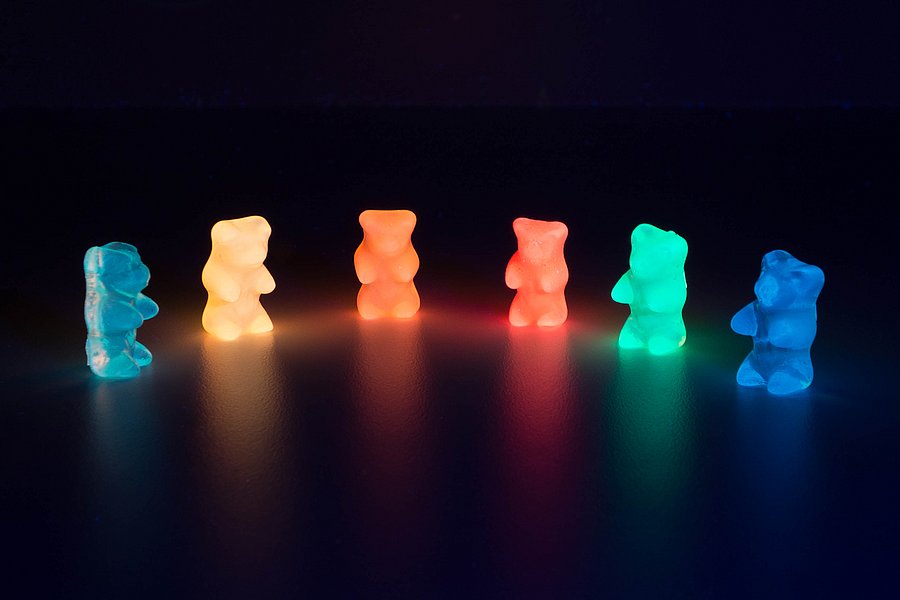Photo – Mol (Photons and Molecules)
Target audience
- Chemistry teachers for lower and higher secondary education
- Students with the goal of becoming chemistry teachers
The experimental kit contains equipment for the following experiments
- Part I: Photoluminescence
- Color by absorption and emission of light
- Luminescent colors by fluorescence and phosphorescence in solution and solids
- Part II: Photochromism
- „Intelligent materials“ with molecular switches
- Photochromism and solvatochromism
- List of all experiments
The kit also comes with
- an accompanying booklet (in German) with 23 work sheets for the lower secondary (7 ws) and higher secondary education (16 ws), didactical tips (contects, basic concepts, skills and curricular integration) as well as risk assessments for all the experiments that are described in the booklet
- an USB stick containing the contents of the accompanying booklet, interactive animations as well as the solutions to the work sheets
Supplements for the kit
Luminescent "gummy bears" (esculin in gelatine; in German)
Fluorescence and phosphorescence in the energy level model (animation)
Video on the creation of an intelligent foil
Video on the extension of the duration of phosphorescence
Possible classroom concept for the lower and higher secondary education are outlined in the slides for the workshop Photons and Molecules
Listing and short description of the experiments described on the work sheets
Experiments for the part on photoluminescence, lower secondary education
Crying Chestnut Branch – Investigation of the fluorescence phenomenon in nature
Investigation of more plants – Fluorescence is not an isolated case in nature
Fluoresceine in Solution – Preparation of a fluoresceine solution
Influence of concentration – Self quenching of fluoresceine if it's concentration is too high, the increase in concentration results in an unespected effect for the students
Investigation of every day objects – Investigation of fluorescence in every day objects
Banana under UV light – Investigations of more fluorescence phenomenons and documentation of a long-term experinet.
Preparation of a phosphorescent sample using esculin – Melting of tartaric acid, addition of esculin and distribution of the molten substance on the surface of the test tube
Experiments for the part on photoluminescence, higher secondary education
Fluoresceine in aqueous solution and with addition of acetone – Quenching of fluorescence by aggregation in aceton in contrast to water.
Fluoresceine in different pH values – Influence of the pH value on the strength of fluorescence of fluoresceine
Esculin in different pH values – Influence of the pH value on the strength of fluorescence of Esculin.
Preparation of phosphorescent sample using esculin using esculin and fluoresceine respectively – Melting of tartaric acid, addition of esculin or fluoresceine respectively, and distribution of the molten dubstance on the glas of the test tube
Investigation of the phosphorescent samples in different temperatures – Influence of temperature on phosphorescence: occurence and duration
Real color emission spectra – Separation of light emitted by an object into its spectral colors; additive mixing of colors
Experiments for the part on photochromism, lower secondary education
Investigation of the intelligent foil – Photosensitivity of the foil, concept of a negative image, creation of images
Investigation of the intelligent foil using various light sources – Only certain parts of the light can cause the intelligent foil to turn blue
Experiments for the part on photochromism, higher secondary education
Powering a photochemical reaction with light – Only light of suitable wavelength can power phorochemical reactions, relation wavelength/light color/energy
Temperature dependence – The speed of a thermal isomerisation depends on temperature, the speed of a photochemical isomerisation is independent from temperature.
Photosteady state – On irradiation with light a different equilibrium is reached that is upheld by continuoous irradiation
Solvatochromism – The wavelength of light absorbed by merocyanine depends heavily on the solvent

